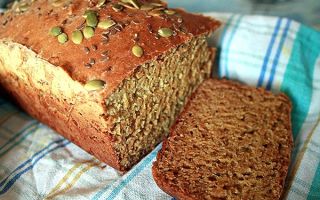Content
- 1 Chemical composition and calorie content of yeast-free bread
- 2 Useful properties of yeast-free bread
- 3 Is it useful to eat yeast-free bread for weight loss
- 4 Is yeast-free bread possible for diabetes and pancreatitis
- 5 Which bread is healthier: yeast-free or yeast-free
- 6 How to make yeast-free bread at home
- 7 Harm of yeast-free bread and contraindications
- 8 Conclusion
Few know what the benefits and harms of yeast-free bread are. Since ancient times, man has been using it for food, and it can be prepared without the use of yeast. The last option is baking, which should be eaten for many diseases, due to the fact that there are no fungal bacteria inside, it will not harm the correct microflora in the intestine, does not contribute to the formation of flatulence, that is, it has useful properties.
There are many videos on making yeast-free bread, but this article lists the most popular cooking methods.

Chemical composition and calorie content of yeast-free bread
All kinds of vitamins are present in the chemical composition of yeast-free bread, it is rich in healing properties. It contains useful vitamins of such groups as PP and B, which stimulate the metabolism of nutrients and help improve brain functioning. The big benefit is that these vitamins are not broken down during cooking, while retaining their beneficial properties. Vitamins of the PP group also contribute to the correct production of many hormones: cortisol, insulin, testosterone, and so on. In yeast-free bread, there are also many other useful components that do not harm, but only contribute to the improvement of the functioning of many organs: magnesium, phosphorus, potassium, proteins and carbohydrates.
Another beneficial property is the relatively low calorie content when compared to other types of bread.
The energy value, or rather, the concentration of proteins, fats and carbohydrates in it, is as follows:
- proteins - 5.7 g (13%);
- fats - 0.51 g (3%);
- carbohydrates - 37.54 (84%).
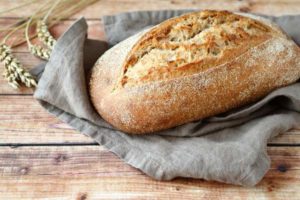
Useful properties of yeast-free bread
If we compare rye bread with other representatives of this product, then it takes the undisputed leadership in terms of calorie content. The second fact of the benefits of yeast-free bread is the complete absence of yeast in it. Scientists have long concluded that they can be harmful to health.
For the gastrointestinal tract
The bread has a very dense structure. It is able to have a beneficial effect on the work of the digestive system as a whole, since eating such a product does not harm digestion, but only significantly reduces the load on the pancreas and liver. Thanks to the use of yeast-free bread, the likelihood of flatulence and stomach problems is reduced.
With anemia
Many modern people, due to the special routine of modern life, are prone to such a dangerous disease as anemia. Its main symptoms are:
- fatigue;
- prostration;
- dizziness;
- pain in the temples.
This is possible due to its saturation with many vitamins and fatty acids.
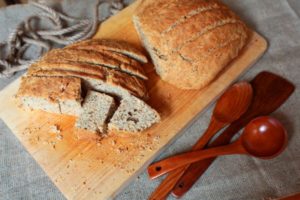
For cancer prevention
The benefits of yeast-free rye bread are undeniable. The composition contains a large number of antioxidants that can act as a good preventive property of many diseases. The presence of selenium, chromium and vitamins of various groups in rye bread without yeast helps to prevent the development of oncology.
With heart disease
Doctors advise to choose a yeast-free product for regular meals for those people who suffer from diseases and heart problems. Regular consumption of such bread will help:
- lower cholesterol levels;
- strengthen the pectoral muscle;
- normalize blood pressure.
For athletes
No less important is yeast-free bread for athletes, as well as for the category of people who adhere to the correct lifestyle. The basis of nutrition is low-calorie food filled with useful components and vitamins, rich in beneficial properties. This is the type of food cooked without yeast. She is able to give more strength and energy, benefitting the body, improve the general condition of the human body.
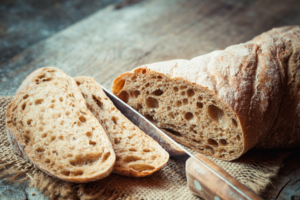
Is it useful to eat yeast-free bread for weight loss
If you want to lose weight without introducing harmful yeast components, an alternative option is suitable in favor of baking and traditional bread, famous for its properties. For weight loss, yeast-free whole grain bread will be useful, its calorie content is very low.
The composition contains useful components due to their properties. Their presence ensures long-term saturation of the body, while a person will receive a minimum of harm and calories, so every girl knows about the benefits of yeast-free bread for a figure. Thanks to its fast-filling properties, the risk of overeating is minimized.
Is yeast-free bread possible for diabetes and pancreatitis
Not only for obesity, experts recommend eating yeast-free baked goods, because they are rich in nutrients and microorganisms, but the calorie content is very low.
The presence of Omega 3 and Omega 6 acids in the composition normalizes the work of the cardiovascular system.
In case of pancreatitis, yeast-free sourdough bread is useful, because it will not irritate the pancreas, but in some cases it will also have a diuretic effect (if it is made with intoxicated sourdough).
Which bread is healthier: yeast-free or yeast-free
After lengthy studies, experts have found that the regular addition of fermentation products to food is only harmful, causing fatigue and rapid fatigue. A person easily perceives the negative factors of the external environment, all useful properties are lost from the product. If you watch lovers of delicious yeast baked goods, you will notice that they have a weak immunity and a quick susceptibility to diseases and infections.
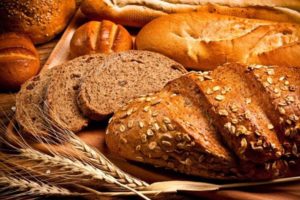
This leads to the conclusion that for constant nutrition it is best to use bread without baker's yeast, which has a positive effect on the body. One point should be taken into account - industrial products do not really contain baker's yeast, but there are other components and specific properties and features. Often in industries to obtain more lush products, special crops are used, which are called wild yeast (hop cones or willow twigs). Studies show that their effect is virtually no different from the effect on the body of baking counterparts.
Therefore, the benefits and harms of store-bought yeast and yeast-free baked goods are the same. If there is a desire to eat healthy nutritious bread, then it should be prepared exclusively on unleavened dough.
How to make yeast-free bread at home
There are a lot of recipes for making bread without the use of yeast bacteria.Among these are soda bread, whose benefits are not inferior to other varieties. Thanks to each of them, you can make a delicious and incredibly healthy product with your own hands. So, baking yeast-free bread on kefir will help to be sure that there will be no harm to the body in the finished product, because they use well-known components and useful properties.
In a bread maker
The easiest way to bake bread from unleavened text is if the kitchen has special equipment - a bread maker.
To prepare a useful fragrant brick you will need:
- 2.5 tbsp. flour;
- 1 tbsp. kefir;
- 1 tsp. soda and salt;
- 0.5 tsp Sahara;
- 2 tbsp. l. sesame seeds.
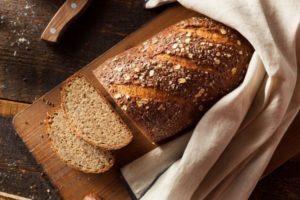
Kefir is poured into the container of the bread machine, then sugar, soda and salt are added. If there is a fear that the components will not mix during the preparation process, then you can pre-mix the dry components in a glass of kefir. Pre-sifted flour, sesame seeds and other spices are poured onto kefir in a mold.
If the device has a special quick baking mode of 750 g, then set it. If this is not the case, then first set stirring for 10 minutes, and then bake for 40 minutes. After turning off the device, you should check the readiness of the bread with a toothpick. If it seems that it is still raw, then additionally set the "baking" mode for 10 minutes, otherwise you can expose the body to harmful effects.
In the oven
Cooking unleavened bread in the oven will not be difficult. It will require:
- 4 tbsp. plain wheat flour;
- 4 tbsp. bran;
- 3 tbsp. kefir;
- 1 tbsp. vegetable oils;
- 1 tsp soda.
Flour, bran and soda are mixed in a large container. Vegetable oil and kefir are mixed separately. Mix both components of the recipe until smooth. The resulting dough is divided into small round pieces.
The oven is heated to 200 ° C before baking. The prepared dough is placed in a preheated oven and baked for 20 minutes. The result is delicious, healthy bread. If you wish, you can experiment with the composition, for example, instead of wheat flour, take a coarser grind.
In a multicooker
For cooking you will need:
- 0.5 l of kefir;
- 100 g of oatmeal, corn and rice flour;
- 250 g wheat flour;
- 1 tsp. salt and soda;
- 30 g butter;
- 50 g sesame seeds;
- 50 g of peeled sunflower seeds.
To prepare a yeast-free product, you will have to purchase wheat flour to grind with butter. Then all dry ingredients and seeds are added and mixed. In parallel, it should be introduced into kefir, soda and salt. Then dry and liquid components are mixed until the mass turns into a thick and sticky dough.
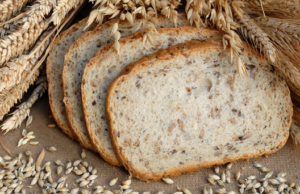
In parallel, the bowl of the device is lubricated with a small amount of oil. Pour the dough, and set in a slow cooker on the baking mode for half an hour. After the device turns off, the cake is turned over and put on heating for 10-15 minutes to brown. Then the bread is taken out and transferred to a basket, covered with a towel on top.
Harm of yeast-free bread and contraindications
Useful and harmful properties of yeast-free bread are two sides of the same coin, and not everything is as rosy and simple as it might initially seem. Such a product sometimes causes enough harm to humans, especially if there is a special component in its chemical composition, which is called wild yeast. Very often, modern manufacturers under the general name "yeast-free bread" sell to their consumers products for the manufacture of which special yeast compositions are used.
Dough for the production of wild yeast is made using hop cones or willow twigs. In essence, as studies have shown, the latter do not differ from traditional bakery.

Conclusion
The benefits and harms of yeast-free bread are obvious.Yeast-free bread will turn out to be a very tasty and complete product, it does not harm. It is a worthy analogue of the usual bread with yeast. Due to its beneficial properties, that is, the presence of cellulose fibers inside, bread has a positive effect on the functioning of the entire digestive system. And the presence of useful components and trace elements makes this product even more valuable. It is especially important to use such bread when losing weight or having some diseases with the digestive system.

